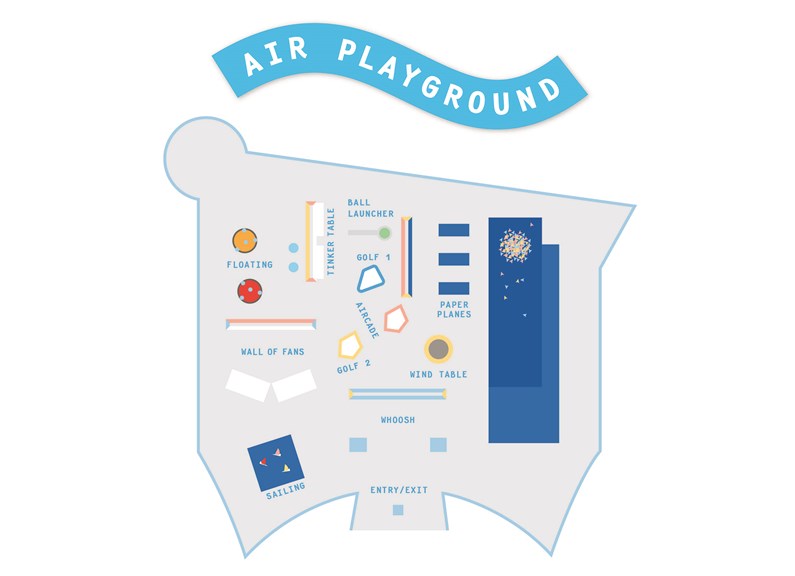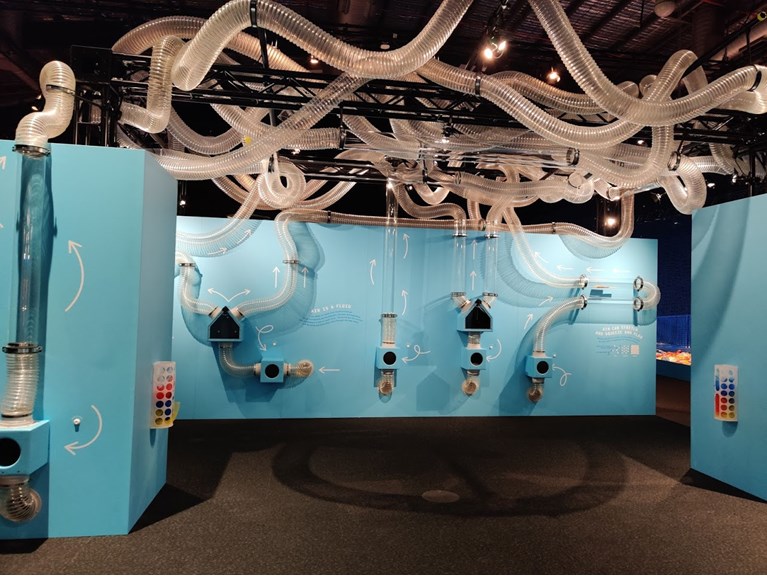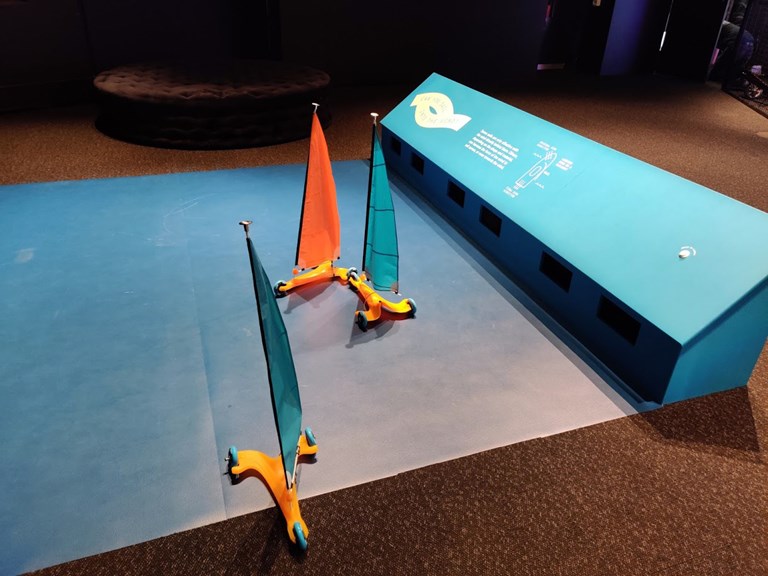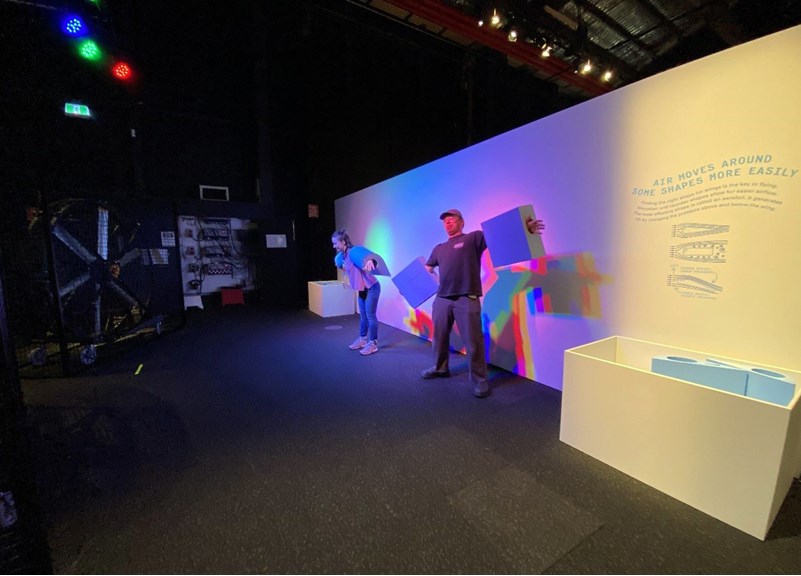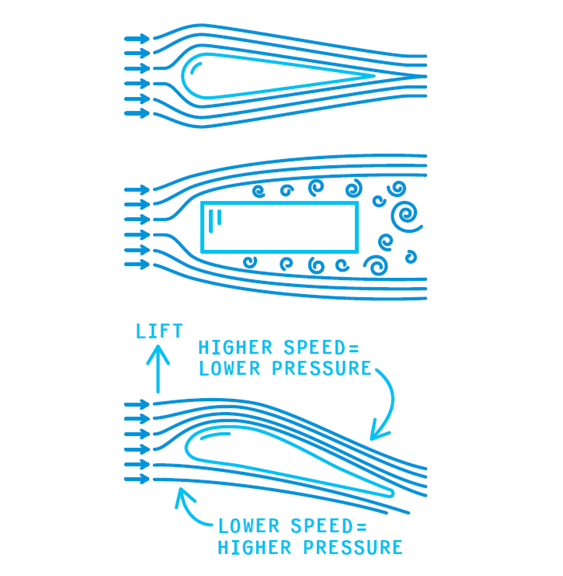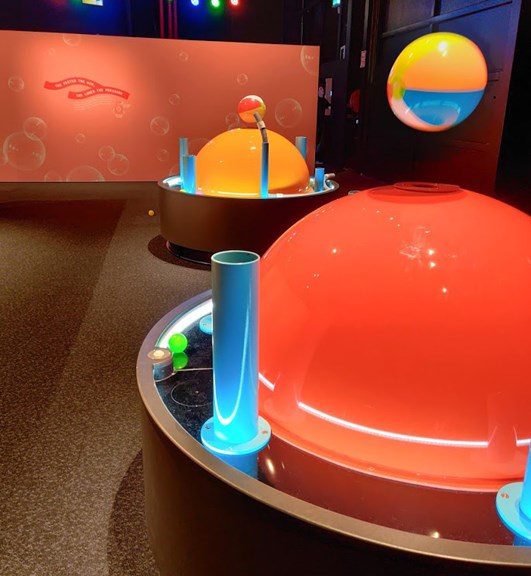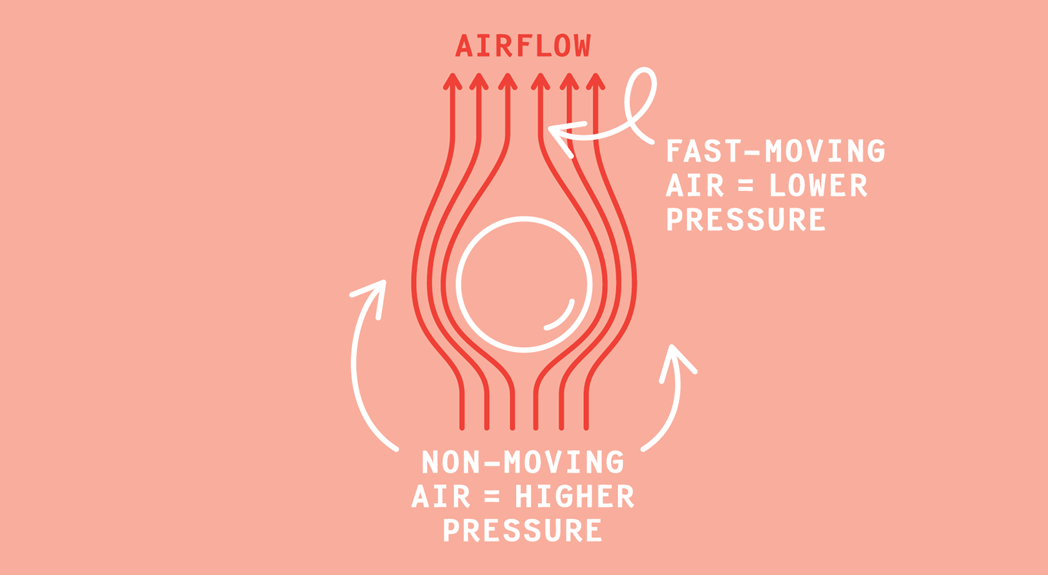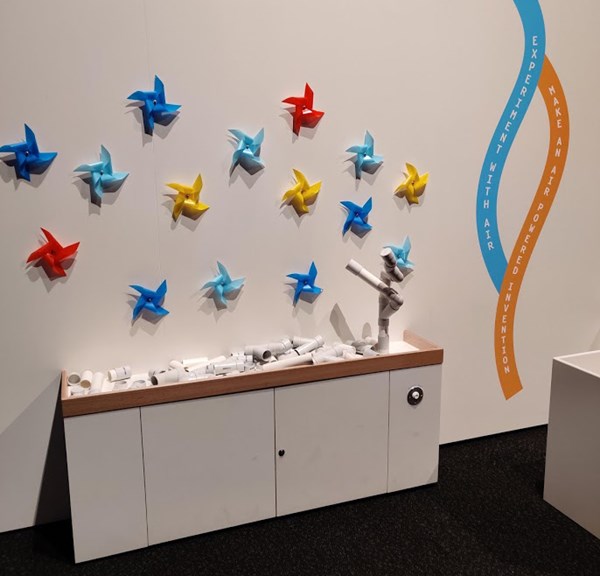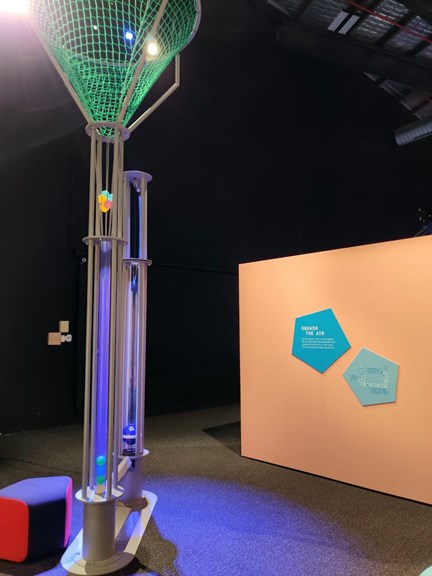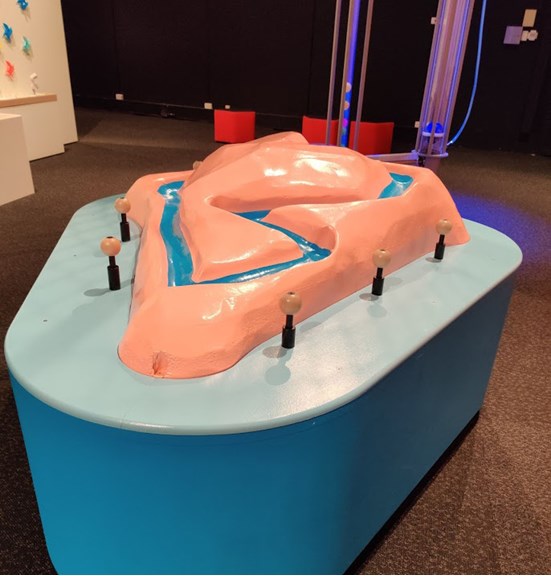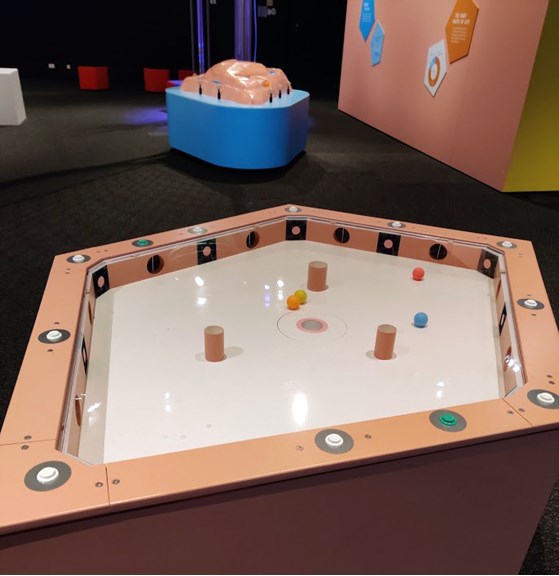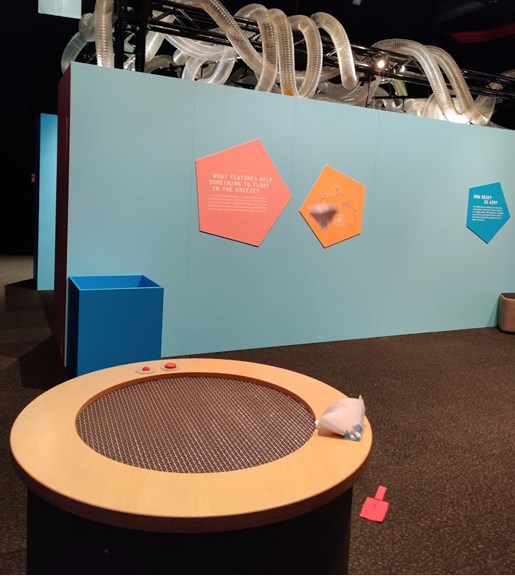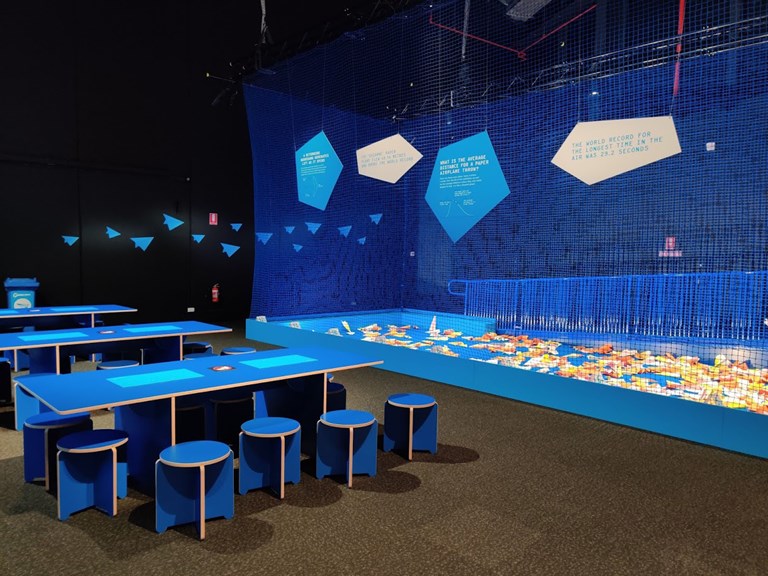Exhibition guide
Download the student kit to use on your excursion:
Whoosh
Students gather up scarves and feed them into one of five inlet holes. The scarf shoots through the tangle of tubes above, before ejecting from the tube and floating to the ground. The tubes have different speeds and lengths. There are also junction points where the direction of the airflow can be changed.
This exhibit lets students play with the various states of air- fast moving through the tubes and slow when it floats to the ground. There’s lots of complex physics at play around compression and airflow but more than that kids love the frenetic energy and experimenting.
- Have you figured out which tube is the fastest?
- Why do you think that is?
- How could we time how long it takes the scarf to move through a tube?
Sailing
There are large fans along one edge of the exhibit. Students experiment with placing the yacht down at different positions and adjusting the sail so that the yacht moves either away from the wind, across the wind or towards the wind. By experimenting with the yacht they learn that a sail is a clever shape that can harness airflow to push the yacht in many different directions, not just away from the wind.
HINT: students should be able to sail towards the wind at about a 45 degree angle from one of the far corners.
- Where else have you seen sails before?
- Which way is the wind blowing?
Can you make your yacht sail:
- Away from the wind?
- Across the wind?
- Towards the wind?
Wall of Fans
Students try on some different shaped wing props and stand in front of a wall of massive fans. This lets them physically feel how large volumes of air interact with different shapes. They might be able to feel some element of lift when they stand in the right position with the wings at a certain angle.
Students might need a little facilitation: help them put on the wings, show them where to stand, take photos, ask them to experiment with tilting their arms at different angles.
Air moves around some shapes more easily: Finding the right shape for wings is the key to flying. Smoother and rounder shapes allow for easier airflow. The most effective shape is called an aerofoil. It generates lift by changing the pressure above and below the wing.
- Try on some of the foam wings and stand with your back to the wall about one step out so you’re right in the flow of air from the three fans.
- Hold your arms up. Tilt the wings up and down. Do you feel any lift? Which shapes move more?
- What kinds of things fly? What shape are their wings?
Floating
There are two round ‘boulders’ with a number of tubes sticking out of them. A button activates air coming out of the tubes. Students play with balancing balls of different sizes in the airflows. Smaller students may need help placing the ball in the airflow or they can try throwing the ball in. Please do not allow students to climb the exhibit.
The Bernoulli effect shows that fast moving air has lower pressure than still air. So the ball that should shoot away gets pushed into and held in the airflow by the higher pressure in the surrounding air.
The faster the air, the lower the pressure: When air is moving it exert less pressure than when it is still. The airflow holds the ball because the fast-moving air has lower pressure than the still air surrounding it. This is called the Bernoulli effect.
Press the button to start the flow of air from the tubes. Try to balance a ball on the stream of air.
- How many balls can you float on one airstream?
- What happens if you put your hand above or below the floating ball?
- Imagine: how might this be useful at school or at home?
Tinker table
This is a more height accessible version of the floating boulders, with the added ability to build parts onto the tubes to redirect the airflow. There are pinwheels mounted to the wall above the fans which will spin if airflow is directed at them. This lets students experiment and construct their own air powered invention. Through experimentation this exhibit builds students’ dexterity, teamwork and creative problem solving skills.
- How many pinwheels can you spin?
- How many more pinwheels can you spin if you join some of the tubes together?
Ball launcher
Students pull back a rope to raise a heavy weight. When the rope is let go, the heavy weight drops and compresses the air in the tube adjoining the two towers. This pushes the smaller balls waiting in the other tube and launches them high in the air before they fall back to the net. If the balls fall out of the net, students can try to throw them back in.
- How does it work? What makes the balls fly up?
- Have you seen any toys that work a similar way?
Golf game 1
A table top minigolf course. Students use contraptions similar to bike pumps to push a ball around an 8 hole course.
Air can be gentle but it can also be squashed and compressed so that it can exert a force on an object. By experimenting with short pushes and harder pushes students get a real grasp of how air acts and can be used.
- How many pumps does it take for you to get the ball all the way around the course?
- Work in a group and use a stopwatch (phone app) to time how fast you can get the ball around the course together.
Golf games 2
There are two different tables for this exhibit where students use fans to move balls into a central hole. They begin by pressing down the green button to launch any balls out of the hole. Then, by gently pressing and holding down the white buttons around the edge, they activate fans which direct the movement of the ball.
By playing with the airflows to try and navigate the ball, students get a feel for the chaotic way that air interacts with itself and physical items around it. One table (pictured) is more complex than the other with obstacles in the way.
- Can you work together to get all the balls into the hole? Or maybe you’d like to pick one colour each and race each other to see who can get their ball in first!
- What is fun or challenging about this game?
- What would your own aircade game look like and how would it work?
Wind table
This is a large table with smooth airflow rising above it. The airflow intensity can be increased by turning the dial. Students experiment with spinning shapes in the airflow to see what floats and what doesn't. By experimenting with different types of floating shapes, students can see what features are common to successful floaters.
- Which things float well on the air table?
- Do they stay still or spin?
- What happens if you change the speed of the air?
- Where have you seen air floaters or spinners in nature?
Paper planes
Students make a paper aeroplane (there are three videos and instructions with diagrams if they don’t know how). They can launch their plane from the top of a ramp along a runway with distance markers along it.
Students are able to experiment with different paper planes to see which design flies the furthest. They will be able to see the average length of a throw and if there are any common design features in the planes that flew the furthest.
- How many metres did your plane fly?
- How far did most of the planes in the exhibit fly? How can you tell?
- What do the planes that flew the furthest look like?
